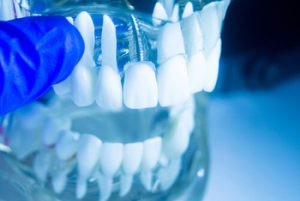In the dynamic world of dentistry, one of the most transformative procedures has been the introduction of dental implants. Dental implants offer a sustainable and lifelike solution for individuals with missing or damaged teeth. The dental implant procedure involves surgically inserting a metal implant, often titanium, into the jawbone beneath the gum tissue. This implant then acts as a sturdy anchor for placing an artificial tooth or several missing teeth, bridging the gap left behind.
It’s crucial to understand the intricacies of this dental implant process. Why? The surgical or invasive procedure carries risks, and an informed patient can make clear decisions. Every phase is crucial, from the initial consultation, where your dentist assesses your oral health, dental, and medical history, to subsequent steps like potential bone grafting to ensure the jaw bone is robust enough for implant placement. Moreover, dental implant surgery isn’t merely about replacing a missing tooth. It aims to restore the function of natural teeth, ensuring that the replacement tooth or teeth can operate in harmony with other teeth.
Understanding the dental implant procedure, from the first step to post-operative care, aids in setting clear expectations and preparing for the journey. Whether it’s anticipating the need for a dental crown after the implant placement or knowing the importance of maintaining good oral health to prevent gum disease, every detail matters. This knowledge ensures the longevity of the dental implant treatment and guarantees a seamless integration with your teeth, giving you the confidence to smile again.
Background on Dental Implants
At its core, the concept behind dental implants is simple yet revolutionary. Dental implants serve as a replacement for tooth roots in individuals with missing teeth. Unlike dental bridges or dentures, which rest on the surface, an implant is surgically inserted into the jawbone beneath the gum tissue. Once in place, these implants provide a sturdy foundation for fixed or removable replacement teeth, or what many would recognise as artificial teeth.

So, why are dental implants often preferred over other tooth replacement options? Firstly, their stability ensures that artificial teeth look, feel, and function almost exactly like natural teeth. This feature is a game-changer in implant dentistry. Unlike dental bridges, there’s no need to alter other natural teeth to support the new tooth. Moreover, dental implants can last a lifetime with proper oral health and care, minimising long-term dental visits and procedures.
Additionally, dental implants prevent bone loss that can occur under missing teeth, maintaining the structural integrity of the jaw and facial shape. Their resilience against tooth decay and their ability to restore full chewing power make the dental implant procedure a transformative choice for those looking to reclaim the full function and aesthetics of their smile.
Who is a Candidate?
Considering a dental implant procedure? It’s essential to understand that while dental implants have revolutionised tooth replacement, only some are automatically suitable candidates. Here’s what you need to know.
Firstly, maintaining excellent oral health is a prerequisite. This is because dental implant surgery involves creating a small opening in the gum tissue to place the implant into the jawbone. Any existing conditions like gum disease can jeopardise the success of the implant and may lead to complications post-surgery.
Secondly, bone density plays a pivotal role. The jawbone is the anchor for the dental implant, providing stability and support. Individuals who’ve experienced bone loss, whether due to tooth loss, periodontal disease, or age, might need bone grafting before implant placement. This surgical procedure aims to augment the jaw bone, ensuring it can securely hold the implant. Alternative tooth replacement options like dental bridges might be recommended when bone loss is too severe.
Lastly, a thorough review of one’s dental and medical history during the initial consultation is imperative. Some factors, such as uncontrolled diabetes, cancer, or habits like smoking, can impede recovery. Furthermore, conditions or treatments that affect bone growth can influence the success rate of dental implant treatment.
Preliminary Steps
Before embarking on receiving dental implants, there are crucial preliminary steps to ensure a successful dental implant procedure.
Consultation with a Dentist:
Your journey begins with an initial consultation with a dentist experienced in implant dentistry. This appointment will assess the viability of implant placement and answer any questions you might have about the dental implant process. It’s the perfect opportunity to discuss concerns, understand the implant procedure in detail, and establish trust with your dental professional.
X-rays and 3D Imaging:
To get a comprehensive view of your jawbone and other teeth, dental X-rays are typically conducted. In some cases, advanced 3D imaging is used to understand the jawbone beneath the gum tissue better. These images are crucial to determining the optimal site for implant placement, ensuring it doesn’t impact your natural teeth, nerve pathways, or sinus cavities. It also aids in the identification of any potential concerns like bone loss, which might require bone grafting before the surgical procedure.
Dental and Medical Health Review:
Your oral health and overall medical history are paramount in the dental implant treatment plan. The dentist will review any signs of gum disease, tooth decay, or other oral health issues that might interfere with the implant procedure. Furthermore, reviewing your medical history, including medications and underlying health conditions, is essential. Certain conditions, for instance, can affect bone growth or healing post-dental surgery.
These preliminary steps are vital in ensuring the suitability of dental implants for your unique needs. Remember, the success of any surgical or invasive procedure lies in meticulous planning and partnering with an appropriately qualified health practitioner. If you’re considering replacing a missing tooth or several missing teeth, these initial measures will pave the way for a new chapter in your oral health.
The Surgical Procedure
Dental implant surgery is a transformative process, allowing individuals to replace missing teeth with artificial teeth that resemble and function like their natural counterparts. This intricate surgical procedure requires precision, experience, and a thorough understanding of the patient’s dental and medical history.
Anaesthesia Options:
Pain management is crucial in any surgical or invasive procedure. Most patients can opt for local anaesthesia, ensuring the implant site is numb during the procedure. However, some might require or prefer sedation or general anaesthesia, especially for complex cases. The dentist will discuss these options and recommend the best based on the patient’s medical history and comfort level.
Step-by-Step of the Implant Surgery:
– Incision and Drilling:
The dentist will make a small incision to expose the jawbone beneath the gum tissue. A specialised drill is then used to create a hole where the implant will be surgically inserted. This process requires meticulous precision to avoid nerve damage and ensure the implant’s stability.
– Placement of the Implant:
A titanium implant acts as an artificial tooth root and is carefully placed into the prepared site. Titanium is the material of choice due to its biocompatibility, allowing bone growth around the implant and ensuring its stability. Once the implant is securely positioned, the surgical site is prepared for suturing.
– Suturing the Gum Tissue:

The dental implant process requires patience. After the surgical procedure, a recovery period allows the jawbone to heal and integrate with the implant, a process called osseointegration. This can take several months, but it’s crucial for the implant’s stability and longevity. During this time, soft foods are recommended to avoid exerting pressure on the new implant.
Post-Surgical Care
Following a dental implant procedure, the post-surgical care phase is pivotal in determining the long-term success of the dental implants. Proper care ensures the implant integrates well with the jawbone and prevents potential complications.
Immediate Aftercare:
After dental implant surgery, most patients will experience some degree of discomfort, including mild pain, swelling, or minor bleeding. Your dentist might prescribe pain medications or recommend over-the-counter pain relief. It’s crucial to avoid strenuous activities and adhere to a diet of soft foods for the initial days post-surgery. This reduces the risk of dislodging the surgically inserted titanium implant. If a temporary crown was placed, ensure you’re gentle around that area.
Potential Complications and How to Avoid Them:
Like any surgical procedure, the dental implant process carries certain risks. These might include infection at the implant site, damage to other teeth, nerve damage, sinus lift complications (if the implant is near the upper jaw), and inadequate bone growth around the implant. To minimise these risks:
– Follow the dentist’s aftercare recommendations rigorously.
– Maintain oral hygiene to prevent gum disease and tooth decay that can jeopardise the implant and other natural teeth.
– Attend follow-up appointments so experienced dentists can monitor the implant placement and oral health.
– Report any unusual discomfort or symptoms to your dentist promptly.
Importance of Oral Hygiene:
Maintaining excellent oral health is beneficial for your natural teeth and crucial for the longevity of your dental implant. Artificial teeth require the same diligent care as your teeth. Regular brushing, flossing, and dental check-ups will help combat potential threats like periodontal disease, which can compromise the surrounding gum tissue and jaw bone. Remember, while the artificial tooth is immune to tooth decay, the surrounding gum tissue and other teeth are not. Thus, a consistent oral hygiene regimen is the backbone of successful implant dentistry.
Post-surgical care is as essential as the implant procedure itself. Adhering to guidelines set by your dentist ensures the smooth integration of the new tooth, promoting a recovery process that paves the way for a long-lasting and functional tooth replacement. Trust in the expertise of appropriately qualified health practitioners and prioritise your oral hygiene to enjoy the benefits of your dental implant treatment fully.
Osseointegration: The Healing Phase
One of the cornerstones of successful dental implant treatment lies in osseointegration. This phase is crucial, ensuring the longevity and stability of the implant in the jawbone. Here, we delve into what osseointegration entails and the care it demands.
What is Osseointegration?
Osseointegration is a natural process wherein the jaw bone fuses with the surgically inserted titanium implant, anchoring it securely, much like the tooth root does with natural teeth. This fusion ensures that the implant provides a stable base for the artificial tooth, mimicking the functionality of one’s teeth. It is a pivotal part of the dental implant procedure, underscoring its biocompatible nature, where the metal implant and the jawbone coalesce seamlessly.
Time Frame for Healing:
The duration of osseointegration can vary based on the individual’s bone quality, dental and medical history, and the specific implant procedure undertaken. On average, this process can range anywhere from three to six months post-dental implant surgery. Factors like bone grafting, if done, might extend the healing period. After the initial consultation and examining dental x-rays, your dentist will provide a more precise timeline tailored to your dental implant placement.
Activities to Avoid During this Period:
While osseointegration is underway, it’s paramount to adhere to specific guidelines to prevent any disturbance to the implant site:
– Dietary Restrictions: Stick to soft foods and avoid chewing directly on the implant site.
– Oral Hygiene: Maintain immaculate oral health to prevent gum disease and potential infections.
– Avoid Smoking: Smoking can inhibit bone growth and delay osseointegration.
– Limit Strenuous Activities, Especially in the initial days following dental implant surgery, to prevent undue pressure on the jawbone.
The process of osseointegration is foundational in implant dentistry. Ensuring proper care during this healing phase guarantees that the dental implant seamlessly integrates with the jawbone, providing a robust and lasting solution for missing teeth. Always lean on the expertise of experienced dentists throughout this recovery process and adhere to their guidelines to optimise the outcome of your dental implant treatment.
Abutment Placement
Following the dental implant procedure, there is a vital step before affixing the artificial tooth or dental crown – the abutment placement. This component plays a pivotal role in completing the dental implant treatment.
Purpose of the Abutment
The abutment is a connector piece that bridges the surgically inserted titanium implant and the artificial tooth, ensuring a secure fit. It acts as an anchor, holding the dental crown or replacement tooth in place, much like the natural tooth root anchors natural teeth.
Secondary Minor Surgical Procedure
Abutment placement requires a minor surgery, typically less invasive than the initial implant surgery. The dentist will expose the implant by making a small incision in the gum tissue during this procedure. Once the implant is accessible, the abutment is attached. While considered part of the dental implant process, this step is distinct from the primary implant placement and might require local anaesthesia for patient comfort.
Healing After Abutment Placement
Post-abutment placement, some gum tissue healing is anticipated. Most patients report only mild pain, which can be managed with pain medications. Continuing a soft foods diet and maintaining optimal oral health can help mitigate potential complications like gum disease. Furthermore, abutment placement is essential in the recovery process, setting the stage for the final tooth replacement – a dental crown or artificial tooth.
Final Prosthesis: The Crown
A pivotal culmination of the dental implant treatment is the placement of the dental crown. This prosthesis is the final piece, restoring both function and aesthetics after a missing or several missing teeth.
Choosing the Right Type of Crown:
Dental crowns come in various materials and designs. During the initial consultation, the dentist, based on the dental and medical history, will discuss the best options tailored to the patient. Factors like the position of the missing tooth, the condition of other teeth, and individual preferences help determine whether a ceramic, metal, or porcelain-fused-to-metal dental crown is appropriate.
The Process of Fitting and Securing the Crown:
After the abutment placement and subsequent healing, the final step in the dental implant process is the crown’s placement. This requires precise measurements. In some cases, dental X-rays or digital scans ensure the crown aligns well with the other natural teeth and the jawbone beneath. The crown is surgically attached to the abutment, ensuring its stability alongside natural teeth. A local anaesthetic might be used to ensure patient comfort during this procedure.
Maintenance and Longevity:
With advancements in implant dentistry, the longevity of dental implants and crowns has substantially increased. However, the implant crown requires care similar to one’s teeth. Regular dental check-ups, good oral health practices, avoiding hard foods, and timely intervention in case of tooth decay or gum disease ensure the prosthesis lasts longer. Although artificial, the crown, like natural teeth, can be susceptible to wear and tear, so being mindful of oral habits is crucial.
Cost and Insurance
Dental implants have emerged as a prominent solution for replacing missing teeth. However, understanding the costs involved and how insurance might aid is essential for potential candidates.
General Cost Range:
The dental implant procedure cost varies widely. While a single tooth implant can be around $3,000, more extensive dental implant treatments involving multiple teeth or additional procedures like bone grafting can significantly increase costs. Most patients find it crucial to get a comprehensive treatment plan after the initial consultation with their dentist to grasp the total expenses involved.
Insurance Considerations:

Factors Affecting Price:
Several factors can affect the total cost of the dental implant procedure. These include the need for preliminary procedures such as bone grafts, the type of dental crown chosen, the expertise of the dentist, and geographical location. Additionally, the number of missing teeth to be replaced and complexities like sinus lifts or issues with jaw bone quality can also influence the overall cost.
Conclusion
In the realm of dental health, the value of dental implants cannot be overstated. These surgically inserted fixtures provide a durable and aesthetically pleasing solution to missing teeth, acting as the closest substitute to natural teeth. Their integration with the jawbone ensures stability, allowing patients to chew, speak, and smile with newfound confidence.
Opting for a dental implant procedure is not merely about replacing a missing tooth but restoring the quality of life and oral health. While dental bridges and artificial teeth offer solutions, dental implants’ longevity, functionality, and natural feel remain unparalleled. However, it’s important to note that the implant process requires expertise, from initial consultation to dental implant placement and recovery. Potential risks, such as nerve damage or complications from bone grafting, reiterate the importance of seeking an appropriately qualified health practitioner for such procedures.
If you or someone you know is considering dental implant treatment, it’s paramount to consult professionals who can guide you through the intricacies of the dental implant procedure. Finesse Dental ensures your dental health journey is smooth and rewarding. Our experienced dentists will evaluate your dental and medical history, recommend a tailored treatment plan, and walk you through the dental implant process.
Take a step towards reclaiming your smile and oral health. Visit Finesse Dental or call us at (02) 8806 0790 to schedule your consultation today. Your journey to a radiant smile begins with a single call.
Note: Any surgical or invasive procedure carries risks. Before proceeding, you should seek a second opinion from an appropriately qualified health practitioner.
References:
pubmed.ncbi.nlm.nih.gov/8699485/
dentalhealth.org/Blog/dental-implants-and-how-crucial-replacing-teeth-really-is
verywellhealth.com/what-to-expect-during-a-dental-implant-procedure-1059372
healthline.com/health/dental-and-oral-health/dental-implant-procedure#seeing-a-dentist
webmd.com/oral-health/types-dental-implants
realself.com/surgical/dental-implants

